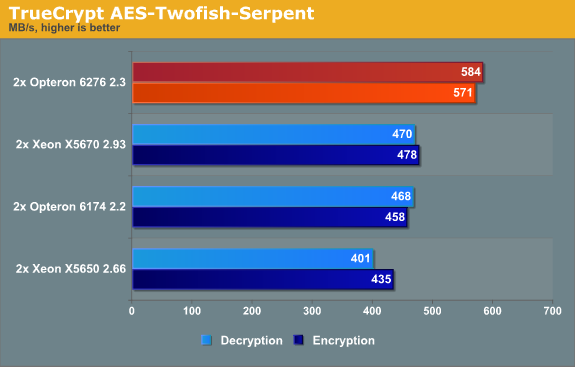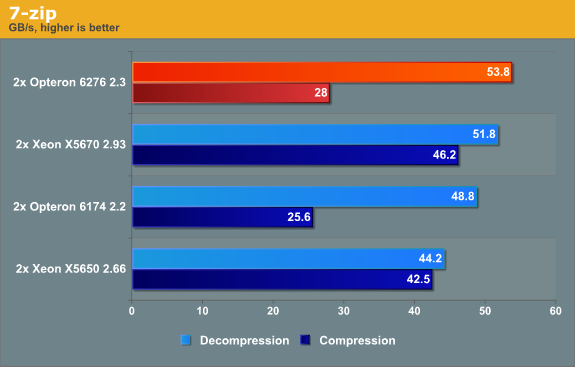Bulldozer for Servers: Testing AMD's "Interlagos" Opteron 6200 Series
by Johan De Gelas on November 15, 2011 5:09 PM ESTTrueCrypt 7.1 Benchmark
TrueCrypt is a software application used for on-the-fly encryption (OTFE). It is free, open source and offers full AES-NI support. The application also features a built-in encryption benchmark that we can use to measure CPU performance. First we test with the AES algorithm (256-bit key, symmetric).

You can compare those numbers directly with Anand's benchmark here. The Core i7-2600K at 3.4GHz delivers 3.4GB/s and the AMD FX-8150 at 3.6GHz about the same 3.3GB/s. We get about 2.3 times the performance here with four times as many "cores", but at 2.3GHz instead of 3.6GHz.
We also test with the heaviest combination of the cascaded algorithms available: Serpent-Twofish-AES.

The combination benchmark is limited by the slowest algorithms: twofish and serpent. The huge advantage that the architectures (Opteron "Bulldozer" and Xeon "Westmere") which support AES-NI had has evaporated: the Opteron 6174 keeps up with the best Xeons. The Opteron 6276 can leverage its higher threadcount as this benchmark scales extremely well.
It is good to realize that these benchmarks are not real-world but rather synthetic. It would be better to test a website that does some encrypting in the background or a fileserver with encrypted partitions. In that case the encryption software is only a small part of the total code being run. A large performance (dis)advantage might translate into a much smaller performance (dis)advantage in that real-world situation.
For example, eight times faster encryption resulted in a website with 23% higher throughput and a 40% faster encrypted file (see here). The advantage that the Xeon had in the first benchmark will not be noticeable, and the Opteron's 24% higher performance will translate into a few percentage points. But this is a benchmark where AMD's efforts to get a 16 integer cores inside a 115W TDP pay off.
7-Zip 9.2
7-zip is a file archiver with a high compression ratio. 7-Zip is open source software, and most of the source code is under the GNU LGPL license

Compression is more CPU intensive than decompression, and the latter depends a little more on memory bandwidth. When it comes to load/stores and memory bandwidth, the Opteron 6276 is unbeateable. We've also seen indications that Bulldozer's cache does very well in reads but not so well in writes, and that could account for some of the gap between the compress/decompress results.
Compression is for a part determined by the quality of the branch predictor (higher than normal branch mispredictions on mediocre branch predictors). The Opteron 6276 has a better branch predictor than the Opteron 6174, but the branch misprediction penalty has grown from 12 to 20 cycles. As a result, a single branch intensive thread runs slower (see Anand's tests) on the newest AMD architecture. Luckily, the AMD Opteron 6276 can compensate for this with its 16 threads (vs 12 threads for the Opteron 6172) and a little bit of help from Turbo Core.
Intel still has the best branch predictors in the industry. The result is that the Xeon is by far the fastest compressor. The end result is that the Xeon is the more rounded CPU in this discipline.










106 Comments
View All Comments
mino - Wednesday, November 16, 2011 - link
More workload ... also you need at least 3 servers for any meaningful redundancy ... even when only needing the power of 1/4 of iether of them.BTW. most cpu's sold in the SMB space are far cry from the 16-core monsters reviewed here ...
JohanAnandtech - Thursday, November 17, 2011 - link
Don't forget the big "Cloud" buyers. Facebook has increased the numbers of server from 10.000 somewhere in 2008 tot 10 times more in 2011. That is one of the reasons why the number of units is still growing.roberto.tomas - Wednesday, November 16, 2011 - link
seems like the front page write and this article are from different versions:from the write up: "Each of the 16 integer threads gets their own integer cluster, complete with integer executions units, a load/store unit, and an L1-data cache"
from the article: "Cores (Modules)/Threads 8/16 [...] L1 Data 8x 64 KB 2-way"
what is really surprising is calling them threads (I thought, like the write up on the front page, that they each had their own independent integer "unit"). If they have their own L1 cache, they are cores as far as I'm concerned. Then again, the article itself seems to suggest just that: they are threads without independent L1 cache.
ps> I post comments only like once a year -- please dont delete my account. every time I do, I have to register anew :D
mino - Wednesday, November 16, 2011 - link
I suits Intel better to call them threads ... so writers are ordered ... only if the pesky reality did not pop up here and there.BD 4200 series is an 1-chip, 4-module, 8(4*2)-core, 16(4*2)-thread processor
BD 6200 series is a 2-chip, 8(2*4)-module, 16(2*4*2)-core, 16(2*4*2)-thread processor
Xeon 5600 series is an (up to) 1-chip, 6-core, 12(6*2)-thread processor.
Simple as cake. :D
rendroid1 - Wednesday, November 16, 2011 - link
The L1 D-cache should be 1 per thread, 4-way, etc.The L1 I-cache is shared by 2 threads per "module", and is 2-way, etc.
JohanAnandtech - Thursday, November 17, 2011 - link
Yep. fixed. :-)Novality77 - Wednesday, November 16, 2011 - link
One thing that I never see in any reviews is remarks about the fact that more cores with lower IPC has added costs when it comes to licensing. For instance Oracle, IBM and most other suppliers charge per core. These costs can add up pretty fast. 10000 per core is not uncommon.....fumigator - Wednesday, November 16, 2011 - link
Great review as usual. I found all the new AMD opterons very interesting. Pairing two in a dual socket G34 would make a multitasking monster on the cheap, and quite future proof.Abour cores vs modules vs hyperthreading, people thinking AMD cores aren't true cores, should consider the following:
adding virtual cores on hyperthreading in intel platforms don't make performance increase 100% per core, but only less than 50%
Also if you look at intel processor photographs, you won't notice the virtual cores anywhere in the pictures.
While in interlagos/bulldozer you could clearly spot each core by its shape inside each module. What surprises me is how small they are, but that's for an entire different discussion.
MossySF - Wednesday, November 16, 2011 - link
I'm waiting to see the follow-up Linux article. The hints in this one confirm my own experiences. At our company, we're 99% FOSS and when using Centos packages, AMD chips run just as fast as Intel chips since it's all compiled with GCC instead of Intel's "disable faster code when running on AMD processors" compiler. As an example, PostgreSQL on native Centos is just as fast on Thuban compared to Sandy Bridge at the same GHz. And when you then virtualize Centos under Centos+KVM, Thuban is 35% faster. (Nehalem goes from 10% slower natively to 50% slower under KVM!)The compiler issue might be something to look at in virtualization tests. If you fake an Intel identifier in your VM, optimizations for new instruction sets might kick in.
http://www.agner.org/optimize/blog/read.php?i=49#1...
UberApfel - Wednesday, November 16, 2011 - link
Amazingly biased review from Anandtech.A fairer comparison would be between the Opteron 6272 ($539 / 8-module) and Xeon E5645 ($579 / 6-core); both common and recent processors.
Yet handpicking the higher clocked Opteron 6276 (for what good reason?) seems to be nothing but an aim to make the new 6200 series seem un-remarkable in both power consumption and performance. The 6272 is cheaper, more common, and would beat the Xeon X5670 in power consumption which half this review is weighted on. Otherwise you should've used the 6282 SE which would compete in performance as well as being the appropriate processor according to your own chart.
Even the chart on Page 1 is designed to make Intel look superior all-around. For what reason would you exclude the Opteron 4274 HE (65W TDP) or the Opteron 4256 EE (35W TDP) from the 'Power Optimized' section?
The ignorance on processor tiers is forgivable even if you're likely paid to write this... but the benchmarks themselves are completely irrelevant. Where's the IIS/Apache/Nginx benchmark? PostgreSQL/SQLite? Facebook's HipHop? Node.js? Java? Something relevant to servers and not something obscure enough to sound professional?